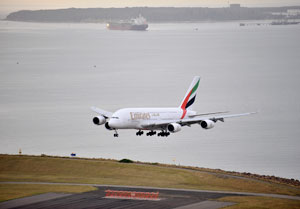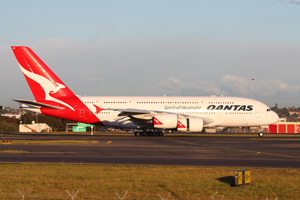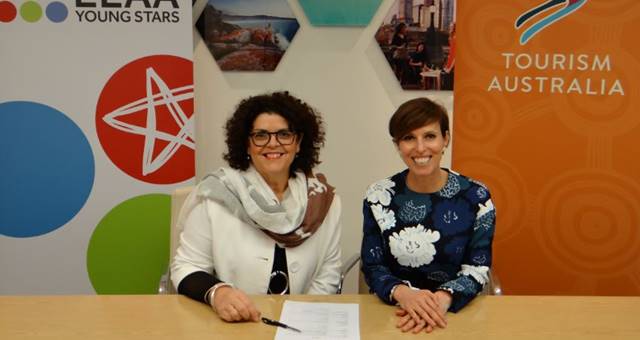By JAMES WILKINSON
Qantas and Emirates have ended weeks of speculation by announcing this morning (Sep 6) a tie-up that involves the Flying Kangaroo re-routing London flights via Dubai and the two premium airlines co-operating on networks, sales and scheduling.

Touch-down: Emirates and Qantas have signed a global
partnership agreement, the biggest ever for both airlines
From April 2013, Qantas will re-route its two Airbus A380 daily flights to London from Melbourne and Sydney via Emirates’ hub of Dubai, replacing the existing services via Singapore.
Qantas will also stop flying to Frankfurt via Singapore – currently operated by the airline’s Boeing 747-400s – and onward codeshares from Singapore to Paris on Air France and from Hong to Rome on Cathay Pacific will also be axed.
Instead, Qantas will feed passengers on Emirates flights to 33 European destinations, up from only five that were served via Asia.
Qantas will also become the only other airline to operate from Emirates’ Terminal 3 in Dubai, something that is part of “the most significant partnership” the Australian airline has ever formed in the carrier’s 92-year history, according to CEO Alan Joyce.
While Qantas has extensive relationships with the likes of American Airlines, British Airways, LAN, South African Airways and China Eastern, Joyce said the Emirates partnership was considered to be “our most premium and important partnership”.
“Emirates is the ideal partner for Qantas [and] we have agreed to join forces to give our customers the most comprehensive premium travel experience on the planet,” he said. “We will be poised to deliver the best in networks, frequencies, lounges, loyalty programs and customer experience.
“This agreement represents a step-change for the aviation industry. It is far bigger than a codeshare. Or even a joint services agreement.
“This is the biggest arrangement Qantas has ever entered into with another airline. [It’s] a ten year partnership, which will be good for all parts of the Qantas Group.
“Subject to regulatory approval, it will include integrated network collaboration with coordinated pricing, sales and scheduling and a benefit-sharing model,” he said.

Singapore-London dumped: Qantas’ A380s are off to
Dubai and London from April 2013
When the 10-year partnership commences, Emirates and Qantas will offer a combined 98 flights per week between Australia and Dubai, from where Qantas passengers will have access to Emirates’ 70 destinations in Europe, the Middle East and Africa.
On the reverse, Emirates will gain 50 Australian destinations served by 5,000 flights per week, as well as access to Qantas services to South East Asia and New Zealand.
When asked about trans-Tasman services by SpiceNews, sectors that served extensively by Emirates and Qantas, Joyce said his airline was looking at new routes as a result of the alliance.
“There are a number of sectors on the Tasman that we don’t operate today,” he said. “That’s something we are looking at.”
Emirates President Tim Clark said “the time was right” to establish a partnership with Qantas.
“By establishing this partnership we are providing our passengers with additional connectivity in Australia and the region, the ability to utilise reciprocal frequent flyer benefits and access to premium lounges and travel experiences,” he said.
Clark said the airlines have “common DNA and a shared vision” and the partnership would help both airlines grow in the international aviation market.
He said “innovation, quality of brands, adaptability, a focus on growth, and most importantly putting customers at the heart of what we do” was a key to the success of the Qantas partnership.
“At its core, the Emirates-Qantas global partnership is about offering more for our customers locally and globally, [it will] allow both airlines to pursue a growth model [and] deal with complex airline economics and deliver an unparalleled global network via two complimentary high quality brands, ” Clark said.
Joyce rejected questions that the partnership would lead to fewer Qantas International flights going forward, saying Asian flying “would be increased” the airline was looking at flying its new Boeing 787-9s, due to be delivered in 2016, to European destinations via Dubai.
Both leaders said under the new alliance, the potential for inbound tourism for Australia was significant.
“With 75 percent of the world’s population within eight hours of Dubai, pending regulatory approval, this extraordinary catchment will now be available for Qantas, along with Australian exporters and Australian tourism,” Clark said.
Joyce added: “There will be considerable benefits for the broader economy as we collaborate with industry to drive more inbound trade and tourism.”
The partnership with Emirates has come at the expense of British Airways, with Qantas set to end its Joint Services Agreement (JSA) with the London-based carrier from the end of March 2013.
While Joyce said he was “looking forward to a continued strong relationship in future” with British Airways, it is not yet known whether codeshare flying will continue on services to London from Bangkok, Hong Kong and Singapore once the JSA ends.


